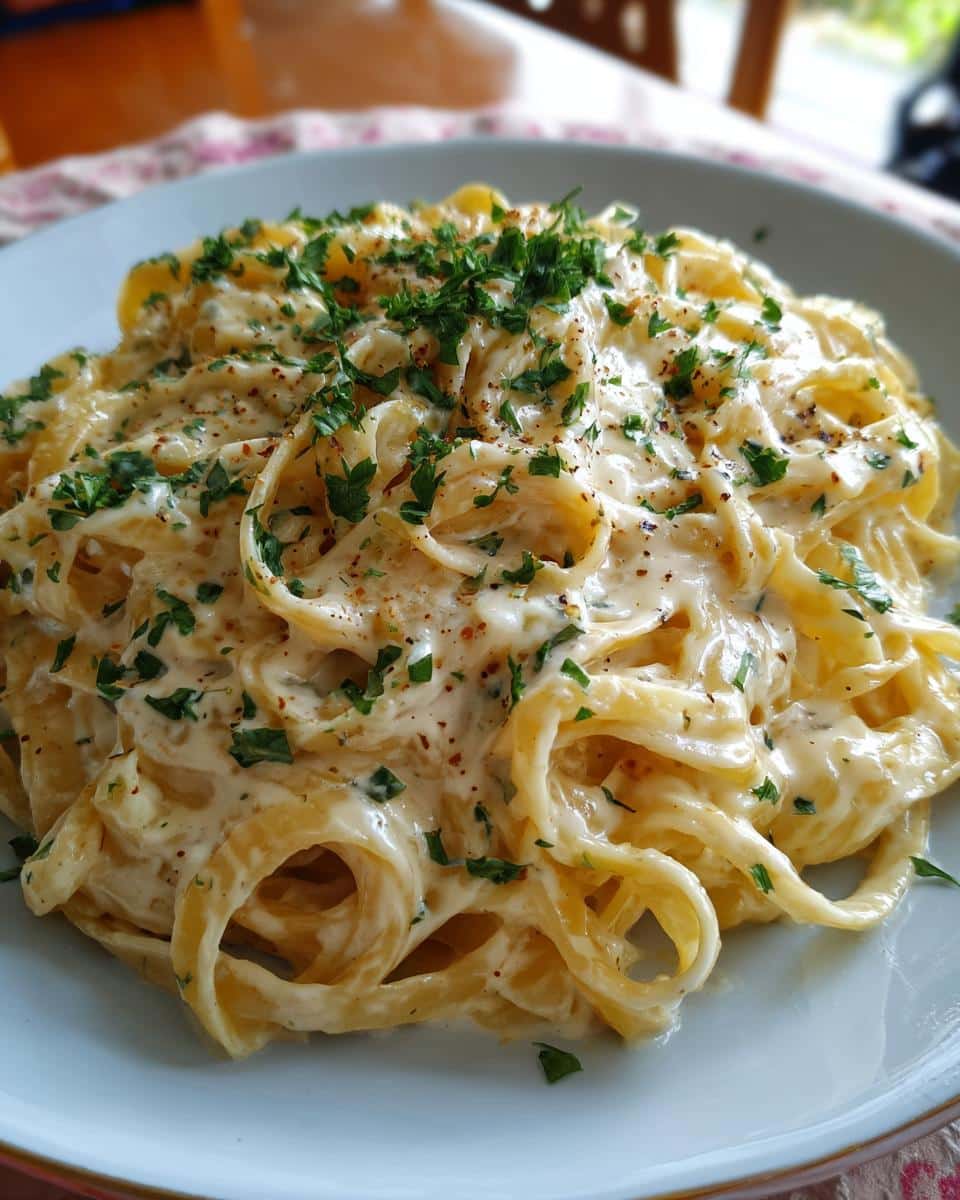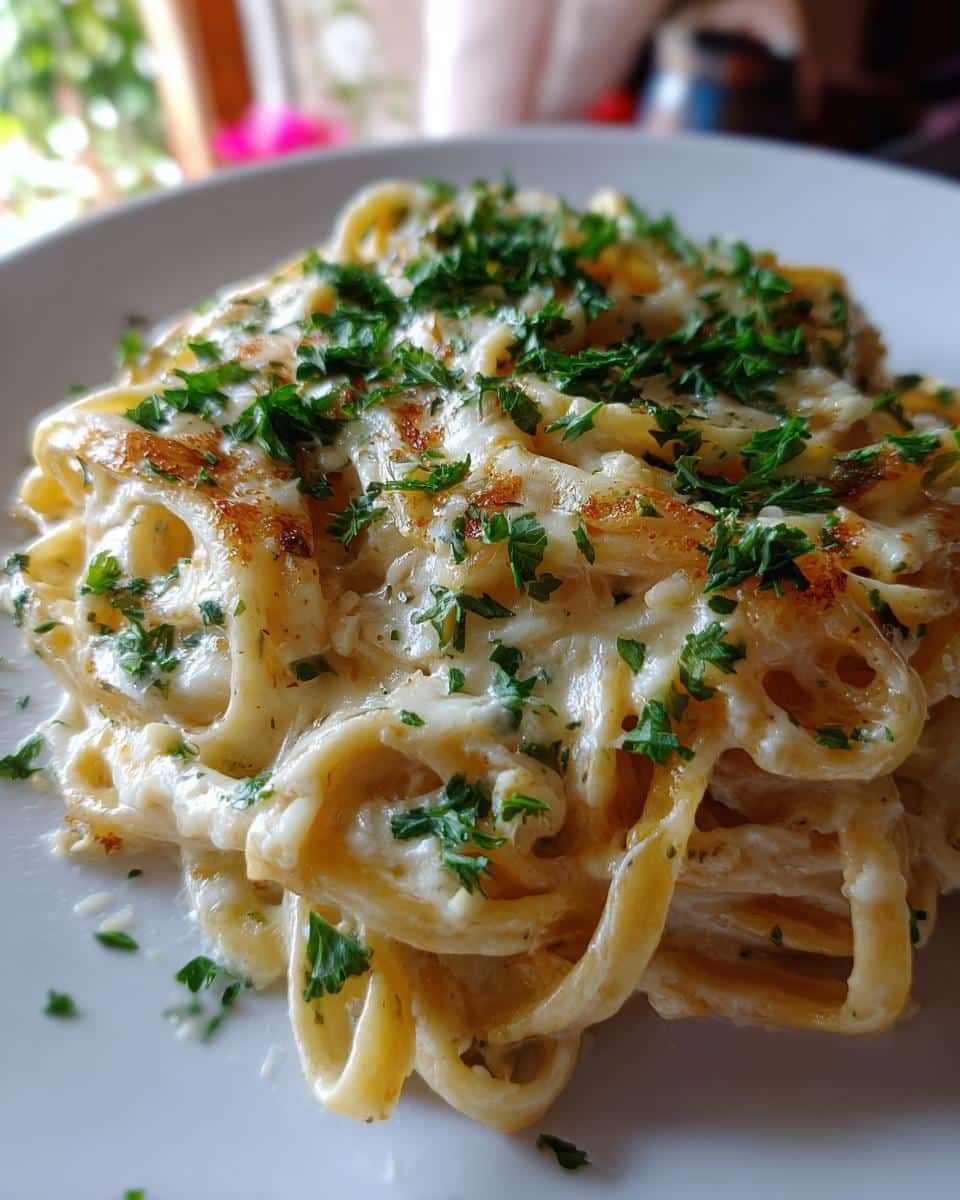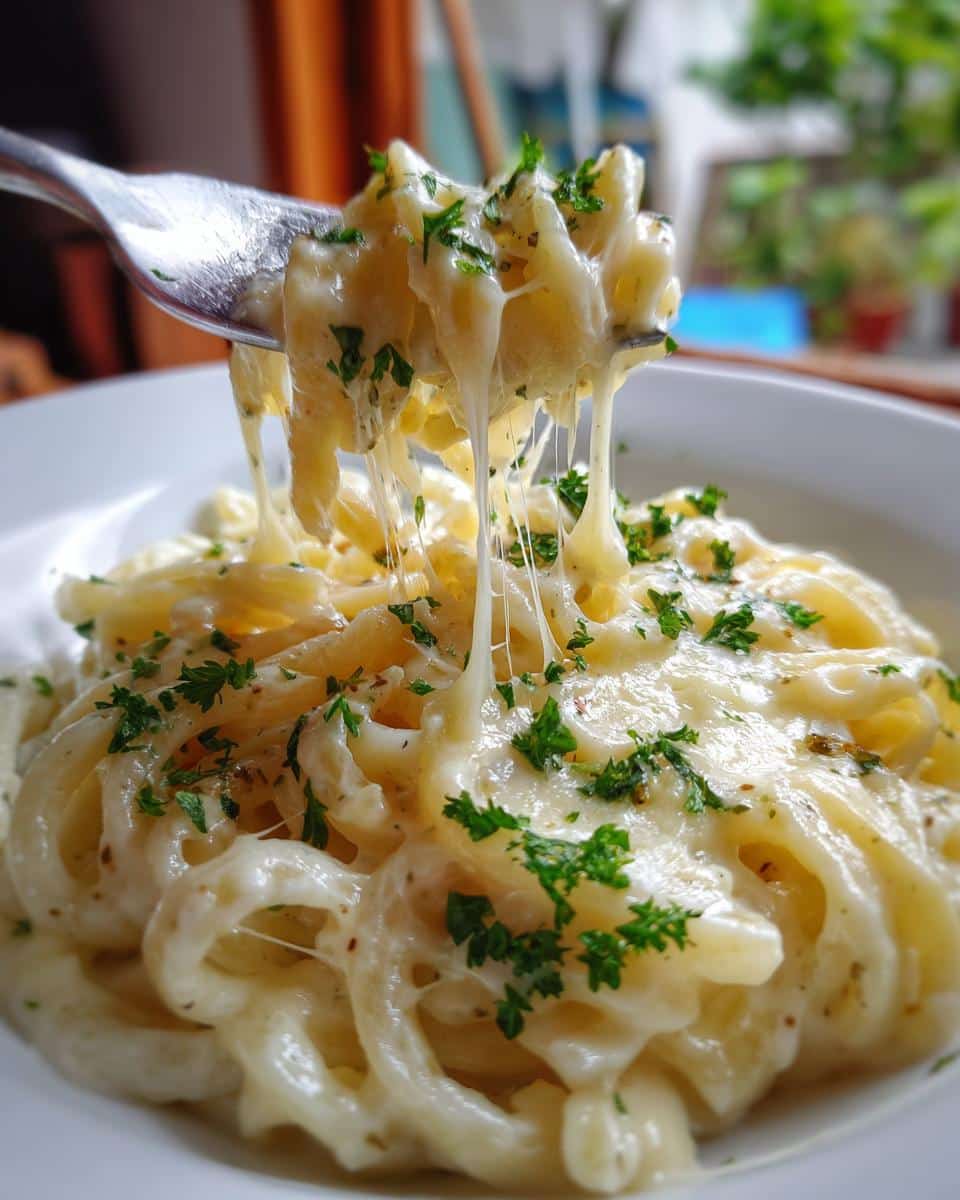Oh my goodness, you have to try these creamy Turkish noodles – they’re absolute comfort food magic! I still remember the first time I had them at a little café in Istanbul, where the rich sauce clung perfectly to every strand of pasta. This dish is beloved across Turkey for good reason – that luscious creaminess balanced with just the right touch of spices will make you feel like you’re dining in a cozy Turkish home.
What I love most (besides how ridiculously easy they are to make) is how the heavy cream transforms into this velvety sauce that coats the noodles so beautifully. My version keeps things simple but packs incredible flavor with garlic, paprika, and a sprinkling of melty cheese on top. Trust me, once you taste these creamy Turkish noodles, they’ll become your new weeknight favorite!

Table of Contents
Table of Contents
Why You’ll Love This Creamy Turkish Noodles Recipe
Let me count the ways this dish will steal your heart (and probably become a weekly staple in your kitchen!):
- Weeknight wonder: From pot to plate in 30 minutes flat – it’s faster than takeout when those creamy noodle cravings hit
- Flavor that hugs you: That rich cream sauce infused with garlic and paprika? Absolute comfort food magic that tastes way fancier than the effort required
- Endlessly adaptable: Dress it up with veggies, keep it simple, or add protein – it’s the perfect blank canvas for whatever’s in your fridge
- Crowd-pleaser: I’ve yet to meet anyone (kids included!) who can resist those silky noodles coated in that dreamy sauce
The best part? You probably have most ingredients already – it’s pantry magic at its creamiest!
Ingredients for Creamy Turkish Noodles
Okay, let’s gather everything you’ll need to make this dreamy dish – I promise it’s all simple stuff! Here’s what you’ll want to have ready:
For the Noodles
- 250g Turkish noodles (or any wide egg noodles if you can’t find Turkish ones – the wider the better for holding that luscious sauce!)
For That Amazing Cream Sauce
- 2 cups heavy cream (this is the star – don’t skimp!)
- 1 tbsp butter (for that rich, authentic flavor)
- 1 onion, finely chopped (I like yellow for sweetness)
- 2 cloves garlic, minced (fresh is best – pre-minced just won’t give the same punch)
- 1 tsp salt (adjust to taste)
- 1/2 tsp black pepper (freshly ground if possible)
- 1/2 tsp paprika (smoked paprika adds incredible depth if you have it)
The Finishing Touches
- 1/4 cup grated cheese (kasar or mozzarella works beautifully)
- Fresh parsley (for that pop of color and freshness)
See? Nothing too fancy – just good, honest ingredients that come together to make something magical. Now let’s get cooking!
Equipment You’ll Need
Don’t worry – you won’t need any fancy gadgets for these creamy Turkish noodles! Just grab:
- A large pot for boiling those noodles (nothing worse than overcrowded pasta!)
- A good-sized sauté pan – I like using my deep skillet so the sauce has room to work its magic
- A wooden spoon for stirring (trust me, you’ll want something sturdy to coat every noodle in that creamy goodness)
- A colander for draining (but save a splash of that starchy pasta water – it’s liquid gold for adjusting sauce consistency!)
How to Make Creamy Turkish Noodles
Alright, let’s dive into making these dreamy creamy Turkish noodles! I’ll walk you through each step so you get that perfect velvety sauce clinging to every noodle – just like they do in Turkey. Don’t worry, it’s easier than you think!
Step 1: Cook the Noodles
First, bring a large pot of salted water to a rolling boil (I use about 1 tablespoon of salt – it should taste like the sea!). Add your Turkish noodles and cook for about 8-10 minutes, or until they’re al dente (still with a tiny bite). Drain them in a colander, but here’s my secret: save about 1/2 cup of that starchy pasta water! It’ll help adjust the sauce later if needed.
Step 2: Prepare the Creamy Sauce
While the noodles cook, melt the butter in your sauté pan over medium heat. Add the chopped onion and cook until it’s soft and translucent, about 3 minutes. Now toss in the minced garlic – oh, that smell is heavenly! Cook for just 30 seconds more (we don’t want burnt garlic!). Pour in the heavy cream, then stir in the salt, pepper, and paprika. Reduce the heat to low and let the sauce simmer gently for about 5 minutes, stirring occasionally. You’ll know it’s ready when it coats the back of your spoon beautifully.
Step 3: Combine and Serve
Time for the magic! Add your drained noodles to the creamy sauce and gently toss everything together until each strand is perfectly coated. If the sauce seems too thick, add a splash of that reserved pasta water. Sprinkle the grated cheese over the top, cover the pan for a minute to let it melt, then finish with a generous handful of fresh parsley. Serve immediately while it’s piping hot – that first creamy, dreamy bite is everything!

Tips for Perfect Creamy Turkish Noodles
After making these creamy Turkish noodles more times than I can count, here are my foolproof tips for absolute perfection every single time:
- Low and slow is the golden rule with the cream sauce – keep that heat gentle to prevent curdling! If it starts bubbling too vigorously, just pull the pan off the heat for a moment.
- Undercook your noodles by about 1 minute – they’ll finish cooking in the hot sauce and stay perfectly al dente rather than turning mushy.
- Taste and adjust the seasoning after combining everything – sometimes I add an extra pinch of paprika or black pepper to make the flavors pop!
- Serve immediately – this dish is at its absolute creamiest when fresh from the pan (though leftovers are still delicious, just add a splash of milk when reheating).
Trust me, these little tricks make all the difference between good noodles and “oh wow, I need seconds!” noodles!
Variations of Creamy Turkish Noodles
One of my favorite things about this recipe is how easily you can switch it up! Here are some delicious ways to play with your creamy Turkish noodles:
- Mushroom magic: Sauté some sliced mushrooms with the onions – their earthy flavor pairs perfectly with the rich cream sauce
- Protein boost: Stir in shredded chicken, ground beef, or even chickpeas for a heartier meal
- Veggie delight: Toss in some spinach right at the end – it wilts beautifully into the warm sauce
- Spice it up: Add a pinch of red pepper flakes if you like things with a little kick
Don’t be afraid to get creative – that’s half the fun of cooking!
Serving Suggestions for Creamy Turkish Noodles
Oh, presentation is half the fun with these creamy Turkish noodles! I love serving them in wide, shallow bowls so you can see all that gorgeous sauce pooling around the noodles. For a complete Turkish feast, pair them with a crisp cucumber-tomato salad (just like they do in Istanbul!) and warm pita bread to scoop up every last bit of sauce. Trust me, your table will look straight out of a Turkish cookbook – and taste even better!
Storage and Reheating Instructions
Leftovers? No problem! These creamy Turkish noodles keep beautifully in an airtight container in the fridge for up to 3 days. When reheating, I like to add a splash of milk or cream to bring back that luscious texture – just warm them gently in a pan over low heat, stirring often. You can freeze them too (without cheese and parsley), though I recommend eating them within a month for best quality. Pro tip: The sauce might thicken in the fridge – just stir in a little warm water or milk when reheating to get that perfect creamy consistency again!
Can I Make Creamy Turkish Noodles Dairy-Free?
Absolutely! Coconut milk works surprisingly well as a heavy cream substitute – just use full-fat for that rich texture. The flavor changes slightly (you’ll get a subtle coconut note), but it’s still delicious. I’ve also had success with cashew cream for a nuttier twist!
Can I Use Regular Pasta Instead of Turkish Noodles?
Of course! While traditional Turkish noodles have a special texture, fettuccine or tagliatelle make great substitutes. Just look for wider noodles that can hold all that creamy goodness. The sauce is so flavorful, it’ll make any pasta taste amazing!
What Cheese Works Best for Topping?
I love kasar (a Turkish cheese) when I can find it, but mozzarella, gruyère, or even parmesan all melt beautifully. The key is using a cheese that gets wonderfully gooey without overpowering the delicate cream sauce.
Is This Dish Kid-Friendly?
Are you kidding? My nieces go crazy for these noodles! For picky eaters, you can tone down the garlic and paprika. Sometimes I serve it with extra cheese on top – that always wins them over!
Nutritional Information
Here’s the approximate nutrition per serving of these dreamy creamy Turkish noodles (but remember, values are just estimates – your actual results may vary slightly depending on specific ingredients used). Each generous portion packs about 450 calories with that perfect balance of carbs, protein, and yes, indulgent creaminess that makes this dish so special!
Important note: Nutritional info is provided as a general guide only. For precise dietary needs, please calculate based on your exact ingredients and portion sizes.

Creamy Turkish Noodles: 1 Soul-Warming Recipe You’ll Crave
A delicious and creamy Turkish noodle dish that combines rich flavors with a smooth texture.
- Prep Time: 10 minutes
- Cook Time: 20 minutes
- Total Time: 30 minutes
- Yield: 4 servings
- Category: Main Dish
- Method: Stovetop
- Cuisine: Turkish
- Diet: Vegetarian
Ingredients
- 250g Turkish noodles
- 2 cups heavy cream
- 1 onion, finely chopped
- 2 cloves garlic, minced
- 1 tbsp butter
- 1 tsp salt
- 1/2 tsp black pepper
- 1/2 tsp paprika
- 1/4 cup grated cheese
- Fresh parsley for garnish
Instructions
- Boil the noodles according to package instructions. Drain and set aside.
- In a pan, melt butter and sauté onion and garlic until soft.
- Add heavy cream, salt, pepper, and paprika. Stir well.
- Simmer on low heat for 5 minutes until the sauce thickens.
- Add the cooked noodles to the sauce and mix gently.
- Sprinkle grated cheese on top and cover until melted.
- Garnish with fresh parsley before serving.
Notes
- For a spicier version, add red pepper flakes.
- Can substitute heavy cream with coconut milk for a dairy-free option.
- Best served hot.
Follow us in Facebook





